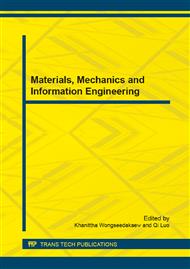[1]
Chun, K. J., Kim, J. H. and Hong, J. S. A study of exhaust valve and seat insert wear depending on cycle numbers. Wear. Vol. 263, No. 7-12, pp.1147-1157, (2007).
DOI: 10.1016/j.wear.2007.02.006
Google Scholar
[2]
Jae Soo Hong, Kayoung Jin Chun. A study on wear and wear mechanism of exhaust valve and seat insert depending on different speeds using a simulator. Journal of Mechanical Science and Technology. Vol. 20, No. 12, pp.2052-2060, (2006).
DOI: 10.1007/bf02916322
Google Scholar
[3]
M. I. Karamangil, A. Avci, H. Bilal. Investigation of the effect of different carbon film thickness on the exhaust valve. Heat and Mass Transfer. Volume 44, No. 5, pp.587-598, (2008).
DOI: 10.1007/s00231-007-0271-6
Google Scholar
[4]
P. Forsberg, P. Hollman, S. Jacobson. Wear mechanism study of exhaust valve system in modern heavy duty combustion engines. Wear. Volume 271, No. 9–10, 2477-2484, (2011).
DOI: 10.1016/j.wear.2010.11.039
Google Scholar
[5]
Murayama Take, Liu Kexian, Ma Ge; engine valve and its material utilization technology. foreign diesel locomotive, 2000, (6): 39-44.
Google Scholar
[6]
Hu Xuegen. A hollow valve and its manufacturing process. Internal combustion engine parts, 2002, (6): 9-14.
Google Scholar
[7]
Lin Jielun. Numerical calculation of internal combustion engine in working process. Xi'an engine working process: Xi'an Jiao Tong University, 1986: 1-118.
Google Scholar
[8]
Zhou Rong. The study and analysis of heat transfer simulation of the engine exhaust valve. Guang Zhou: South China University of Technology, 2010: 1-60.
Google Scholar
[9]
Liuxiaoping, GuoLan. Simulation Analysis of Engine Exhaust Valve Failure. Auto Engineer. 2010, (3) : 39-46.
Google Scholar
[10]
Lin Fenggong, Lin Hua, Cheng Yongqiang. Transient Thermal-field Numercal Analysis of The Engine Exhaust Valve. Agricultural Equipment & Vehicle Engineering, 2009, (10): 30-33.
Google Scholar
[11]
Lin Fenggong, Yuan Mu, Ma Wei. Numerical Analysis of Thermal-Mechanical-Coupled Stress of Engine Exhaust Valve. Agricultural Equipment & Vehicle Engineering, 2010, (4): 34-37.
Google Scholar
[12]
Zhou Tingmei, Lv Juncheng, Mo Yimin. The Dynamics and Temperature Field Three-dimensional Data of Engine Valve. Internal Combustion Engines, 2004, (6): 7-15.
Google Scholar
[13]
Wang Lin, Liu Zuomin, Pei Xin. The Failure Analysis of the Engine Valves By I-DEAS. Journal of WuHan University of Technology. 2002, 24(3): 33-36.
Google Scholar


